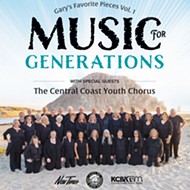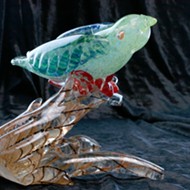The Bard's factory of dreams, realized
After last summer's unexpected leave of absence, the Central Coast Shakespeare Festival is back on its feet
By Anna Weltner[{
"name": "Ad - Medium Rectangle CC01 - 300x250",
"id": "AdMediumRectangleCC01300x250",
"class": "inlineCenter",
"insertPoint": "8",
"component": "2963441",
"requiredCountToDisplay": "12"
},{
"name": "Ad - Medium Rectangle LC01 - 300x250",
"id": "AdMediumRectangleCC01300x250",
"class": "inlineCenter",
"insertPoint": "18",
"component": "2963441",
"requiredCountToDisplay": "22"
},{
"name": "Ad - Medium Rectangle LC09 - 300x250",
"id": "AdMediumRectangleLC09300x250",
"class": "inlineCenter",
"insertPoint": "28",
"component": "3252660",
"requiredCountToDisplay": "32"
}]
Shakespeare himself had problems securing a venue for his venerable plays. Whether torn down by Puritans or burnt to the ground after a cannon misfire during Henry VIII, there was always something going awry at the Globe Theatre. When a landlord claimed the Globe belonged to him, Shakespeare’s company waited until the landlord went away for Christmas, then dismantled the building, beam by beam, and ferried it across the Thames.
In keeping with its namesake, the Central Coast Shakespeare Festival has never let a little thing like finding itself temporarily homeless get in its way for too long (well, “homeless” is a scary term; let’s just call it “in between venues”).
In what local thespians mourned as a case of “art tongue-tied by authority,” last year’s Central Coast Shakespeare Festival failed to materialize. The beloved festival’s venue of five years, Bellevue Charter School, deemed the event an insurance liability just two months before the start of the 2008 summer season. For want of a venue, the festival was cancelled.
New Times sat down with Artistic Director Zoe Saba, directors Cindy Totten and Michael Hofacre, and actor/volunteer PR coordinator Patty Thayer to discuss the return of the festival.
Last summer, it seemed the only good thing about the cancellation was one extra year to raise funds and dream up a better festival. Now, said Saba, “To be honest with you, I don’t think much about the cancellation. It’s something that happened, and we’ve moved forward.” Last July, after New Times ran a story about the cancellation, it was clear that the community was ready and able get the festival going again. Said Saba, “We started getting e-mails and phone messages from all over the county” with suggestions and even direct offers for a new venue. “It was sort of like Christmas morning,” she recalled.
Saba and company eventually settled on River Oaks Hot Springs in Paso Robles. An outdoor setting such as this one, where art and nature can play together, is integral to the festival. Families can picnic on the grass, perhaps pop open a bottle of wine, and enjoy this year’s theatrical offerings: Shakespeare’s A Midsummer Night’s Dream and a stage adaptation of Robert Louis Stevenson’s Treasure Island.
Of course, the depiction of artistic expression flourishing in a depression-era setting may hit home with playgoers this year as well.
“The art of a community helps to define its soul, its personality,” said Saba. “Especially in times like these, when people lose their jobs, businesses are closing, and people are just frustrated about the world. Where do we turn in times of frustration and despair? We turn to art.”
Like Midsummer, Treasure Island, co-directed by Saba and Florida drama instructor Totten, has undergone a few changes as well. Thanks to a bit of gender-bending, there are more sea wenches in this version; the lead role of Jim Hawkins is even played by a woman (Arisa Bega). This adaptation (by Phil Willmott) also features an unexpected but not unwelcome rock-and-roll tribute to cheese. While that bit wasn’t in Stevenson’s original novel, it serves its purpose in underscoring the purposeful campiness and levity of Willmott’s adaptation.
The more family-friendly of the two shows, Treasure Island is big on audience participation. Thanks to the outdoor setting, the actors can move among the audience, freely interacting with (perhaps even stealing food from) playgoers.The cast is chock full of gems, though the standout role may be Alan Benson’s portrayal of crusty knave Long John Silver, piracy’s answer to today’s aging British rock star (permanently fried, yet somehow charming, but still not someone you would choose to babysit your children).
Performances occur in repertory, meaning that shows are presented on alternating weeks, with roughly the same cast appearing in both. While acting in two different plays at once is impressive, particularly strong performances include Janet Stipicevich as Treasure Island’s Lady Trelawney and Midsummer’s Quince. Melanie Marshall nails Stevenson’s brassy barmaid Meg Trueblood and Shakespeare’s Hermia. Greg Marshall delivers as both Israel Hand and Oberon, king of the faeries. Patty Thayer, the festival’s volunteer PR coordinator (also marketing director for the SLO Symphony) is spectacular as Titania, Midsummer’s faerie queen.
Last summer’s leave of absence may have given Saba time to wax philosophical about why actors do what they do. It’s obvious that, at the Shakespeare Festival, theater represents something far more meaningful than an evening’s entertainment. On the contrary, said Saba, theater is “a way to revisit our shared humanity.” It is an art that must be shared—fire, Puritans, and insurance liabilities notwithstanding. As an audience, said Saba, “We gather together as strangers, and we leave having had a shared experience, a unique experience that will never again be the same.” ∆
Anna Weltner thanks New Times for printing her scribbles over the past year or so. Send comments to Arts Editor Ashley Schwellenbach at [email protected].












